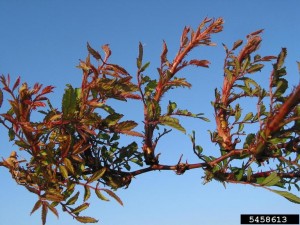Did your roses look odd this past year — stems and leaves that stayed red all summer, or lots of stems or buds all bunched together? (Those bunches are called “witches’ brooms.”) If so, they could have rose rosette disease — a virus carried by a miniscule mite.

It may be just a small branch affected at first but rose rosette is a serious disease. It can infect and kill almost all types of roses and spread from plant to plant. What to do? Remember your IPM principles and scout! Inspect your roses often for first signs of the virus. Even wild roses can carry it, so look at those too. You can check this fall and if you are not sure, mark those plants to look at again in the spring.
Found symptoms? Remove symptomatic plants to keep rose rosette from spreading. It’s unlikely that pruning out infected parts will save your roses or keep the mites from hopping onto neighboring plants to feed and infect them. And bag each plant right away! Don’t carry them through the garden dropping mites as you go.

When you buy roses next time, inspect them carefully — not just the ones you are buying but all the roses around them. If you see symptoms, try a different store. The symptoms don’t show up right away. And the last thing you want to do is bring home a Typhoid Rosie.
Can you replant in the same place? Some resources suggest the virus can move from the old roots to the new. So give your new rose a new home.
Stay tuned! While we don’t have answers now on how to protect your rose garden, there is research in progress that should help us keep our roses red and our growers not so blue.
For more information, see University of Tennessee’s Observations on Rose Rosette Disease.